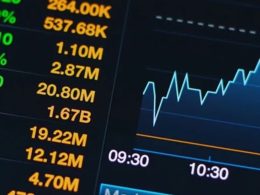by Todd Mathias, CFA, Franklin Templeton Investments
Here are some highlights from the podcast:
- There’s been an evolution within emerging markets and not only in terms of the demographics, but also the investible opportunities.
- Traditionally most investors had thought of emerging-market economies as driven solely by commodities. But that’s changed.
- Institutions and advisors are struggling with smart beta and where it sits within their portfolio. In our view, it’s truly complementary with active and passive strategies.
Tune in to our latest “Talking Markets” podcast.
Host/Richard Banks: Hello and welcome to Talking Markets: exclusive and unique insights from Franklin Templeton. I’m your host, Richard Banks.
Ahead on this episode, we learn about smart beta investing. You’ll hear how smart beta could be viewed as an additive investment strategy, as opposed to being a replacement for active or passive investing. And, how a multi-factor approach may address the challenges that come with single-factor investing.
Putting it all into context, we look at the changing investment landscape in emerging markets. We hope you enjoy the conversation with Franklin Templeton ETF Specialists Todd Mathias and Rick Felix. Rick, take it away.
Rick Felix: Let’s jump right into it. The emerging markets, you know, we look back all the way to the credit crisis. It’s been a little bit of a ride. You know, 10 years—three of those 10 years you had the best-performing equity asset class, you were riding high, so to speak. However, three of those 10 years, it was the worst-performing equity asset class, but we come to today. What are we seeing? Where are the opportunities?
Todd Mathias: You know, one of the things you mentioned was this kind of wild ride and that has to do with risk. You know, I think many advisors are still in the hesitation or caution mode, given risks in emerging markets. And that could be looming tariffs is one that comes up often, but I think there’s a, a sense of renewed optimism. And a lot of that is on the back of kind of the change in the Fed [US Federal Reserve] policy, where the US dollar sits relative to emerging market currencies and allows us to refocus on two kind of key areas.
One, valuations; the discounts. So not only are emerging markets sitting at a 21% discount today to their developed market peers, they’re actually sitting at a 20% discount to their long-term average, um, with increasing ROE [return on equity], so increasing profitability and allows us to refocus on that second area. That second area is the long-term growth opportunities.
Todd Mathias: GDP [gross domestic product] growth rates projected into 2023, almost three times developed-market peers.1 And then if you go into consumption [growth] rates, you’re looking at 193% projected into 2030 relative to developed markets at just 10%.2 And these are just two areas that are really scratching the surface.
Rick Felix: So you mentioned the consumption rate and of course that has to deal with, with the consumer, you know, and traditionally we thought of the emerging markets and their economies derived solely from commodities. How much has that dynamic changed over the last 10 years?
Todd Mathias: You’re exactly right. There’s been an evolution within emerging markets and that’s not only from the demographic, but then the investible opportunity. You’ve seen, the emerging markets, which 10 years ago, half of emerging market economies had a positive dependence on commodities, that’s less than one-third today.3 And that actually then transcends right into the investible opportunities. So if you were to look at technology that’s now almost doubled in terms of its representation of a broad market index. We’ve seen the same for consumer discretionary. And then in turn, you’ve seen materials and energy almost go in half. So really this doesn’t surprise me when I see 86% of millennials live in emerging-market economies.
Rick Felix: Wow, Let’s take a step back. So multifactor investing, smart beta. We take a look at the investment spectrum. We have active management on one end, we have passive on one end, where does smart beta fit in that active-passive spectrum?
Todd Mathias: You can view it as this continuum or this spectrum. And I think that’s how many investors have viewed it historically too. I’ve got two choices. I can use active management, and there’s some great and attractive attributes to active management, right? I’m going to pay a little bit more, but I have someone behind the wheel that’s navigating these volatile markets for me, offering me some downside protection and some hopes for alpha production. And then on the flip side, especially over this past decade, you’ve seen this gravitation towards passive management for the low cost with within the ETF for tax efficiency and then unbelievably transparent.
Smart beta sits somewhere in the middle, polling on the attributes that we all love and care about both. So from active, you do have an ability to seek a desired outcome. But then, you also get a lot of those attributes of passive management. Typically, lower in costs within that ETF wrapper that you can have certain tax efficiency benefits. And then, lastly, transparent tends to be index-based. So, transparent rules-based allows me to know what I’m holding at any point in time.
Rick Felix: Is smart beta new?
Todd Mathias: Smart beta, itself, is a term that’s quite loosely thrown around in asset management. The term itself may have some newness to it, so coined in 2003 from a well-known consultant. But really those merits that are the foundation for smart beta are factor-based investing, really drivers of risk and return of those securities that dates back all the way to the 1930s and academic literature, explaining the drivers of this risk and return. So this is Graham and Dodd, value investing, high- quality investing and that academic literature just continues, but importantly is the economic intuition why asset managers have tapped into factors to drive the risk and return of their active portfolios to manage risk, to produce alpha. What’s new is now you have this third style of investing, smart beta—the ability to capture those factors within a rules-based transparent design. And that’s smart beta.
Todd Mathias: And a lot of that is because accessibility of data, you know, we’re in a modern age, so the smart beta term is new, but it’s foundations are old.
Rick Felix: Hmm. Okay. We’ve seen a lot of single-factor ETFs and I know you watch the ETF flows, so you’ve probably seen that through the flows. And I know, within our conversations, we see, you know, a wide range of performance year-over-year between those factors.
Todd Mathias: It’s hard not to ignore the flows as well as the performance of single-factor investing. A lot of clients would say, oh, can I time this? Is there a way I can move in and out and benefit from one performance being better than the other? And I think 2017, is a great example. That spread is unbelievably wide, almost 23%,4 between the best-performing factor and the worst-performing factor. So that challenges market timing. I think we all know how challenging that can be and whether I want to do that. Institutions and advisors, alike, struggle in seeing this third style of investing, smart beta, and where does it sit within their portfolio? Do I have to sell my active manager? Do I have to sell my passive manager? It’s not a this-or-that conversation. It’s truly very complementary. And it comes down to what is the magnitude of investment do I want in smart beta?
Host/Richard Banks: And thank you for listening. If you’ve enjoyed these insights and would like to hear more, check out our archive of previous episodes and subscribe on iTunes, Google Play or just about any other major podcast provider. So until next time, when we uncover more insights from our on the ground investment professionals, goodbye.
To get insights from Franklin Templeton delivered to your inbox, subscribe to the Beyond Bulls & Bears blog.
For timely investing tidbits, follow us on Twitter @FTI_Global and on LinkedIn.
CFA® and Chartered Financial Analyst® are trademarks owned by CFA Institute.
What Are the Risks?
All investments involve risks, including possible loss of principal. The value of investments can go down as well as up, and investors may not get back the full amount invested. Generally, those offering potential for higher returns are accompanied by a higher degree of risk. Stock prices fluctuate, sometimes rapidly and dramatically, due to factors affecting individual companies, particular industries or sectors, or general market conditions. Bond prices are affected by interest rate changes. Bond prices, and thus a bond fund’s share price, generally move in the opposite direction of interest rates. As the price of bonds in a fund adjusts to a rise in interest rates, the fund’s share price may decline. Special risks are associated with foreign investing, including currency fluctuations, economic instability and political developments; investments in emerging markets involve heightened risks related to the same factors. To the extent the fund focuses on particular countries, regions, industries, sectors or types of investment from time to time, it may be subject to greater risks of adverse developments in such areas of focus than a fund that invests in a wider variety of countries, regions, industries, sectors or investments. Smaller, mid-sized and relatively new or unseasoned companies can be particularly sensitive to changing economic conditions, and their prospects for growth are less certain than those of larger, more established companies. Historically, these securities have experienced more price volatility than larger company stocks, especially over the short-term. Performance of the funds may vary significantly from the performance of an index, as a result of transactions costs, expenses and other factors. For smart beta ETFs, there can be no assurance that a fund’s multi-factor stock selection process will enhance performance. Exposure to such investment factors may detract from performance in some market environments, perhaps for extended periods. For actively managed ETFs, there is no guarantee that the manager’s investment decisions will produce the desired results.
ETFs trade like stocks, fluctuate in market value and may trade at prices above or below their net asset value. Brokerage commissions and ETF expenses will reduce returns. ETF shares may be bought or sold throughout the day at their market price, not their Net Asset Value (NAV), on the exchange on which they are listed. Shares of ETFs are tradable on secondary markets and may trade either at a premium or a discount to their NAV on the secondary market.
IMPORTANT LEGAL INFORMATION
This material is intended to be of general interest only and should not be construed as individual investment advice or a recommendation or solicitation to buy, sell or hold any security or to adopt any investment strategy. It does not constitute legal or tax advice.
The views expressed are those of the investment manager and the comments, opinions and analyses are rendered as at publication date and may change without notice. The information provided in this material is not intended as a complete analysis of every material fact regarding any country, region or market. All investments involve risks, including possible loss of principal.
Data from third party sources may have been used in the preparation of this material and Franklin Templeton Investments (“FTI”) has not independently verified, validated or audited such data. FTI accepts no liability whatsoever for any loss arising from use of this information and reliance upon the comments opinions and analyses in the material is at the sole discretion of the user.
______________________
1. Source: Bloomberg and International Monetary Fund, World Economic Outlook Database, as of October 31, 2018. There is no assurance that any estimate, forecast or projection will be realised.
2. Source: Brookings Research Institute. “Projected Consumption” measured by Middle Class Expenditure.
3. Source: FactSet as at 30 December 2018; MSCI Emerging Markets Sector Weightings.
4. Source: Morningstar Direct as at 31 December 2018.
Copyright © Franklin Templeton Investments















